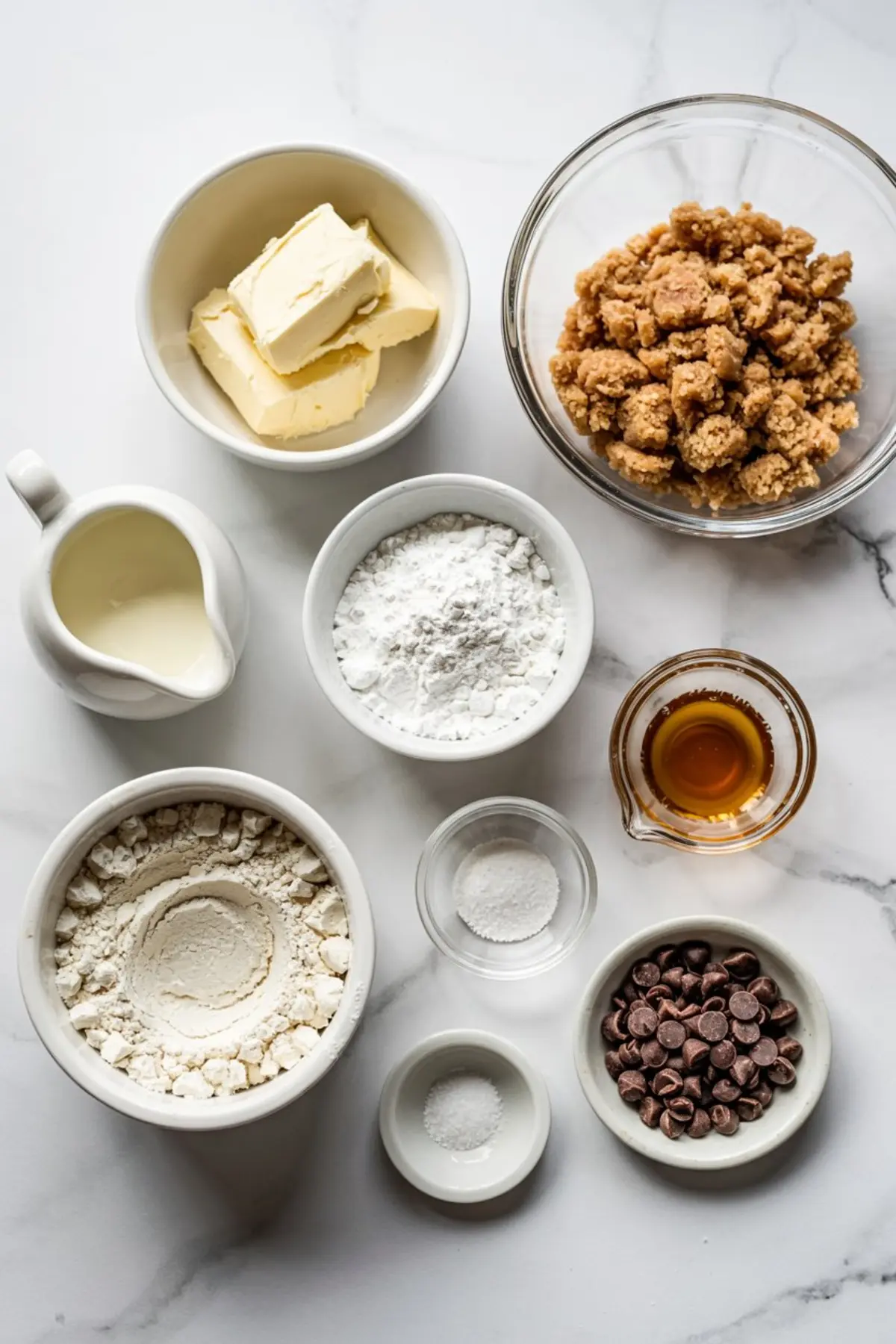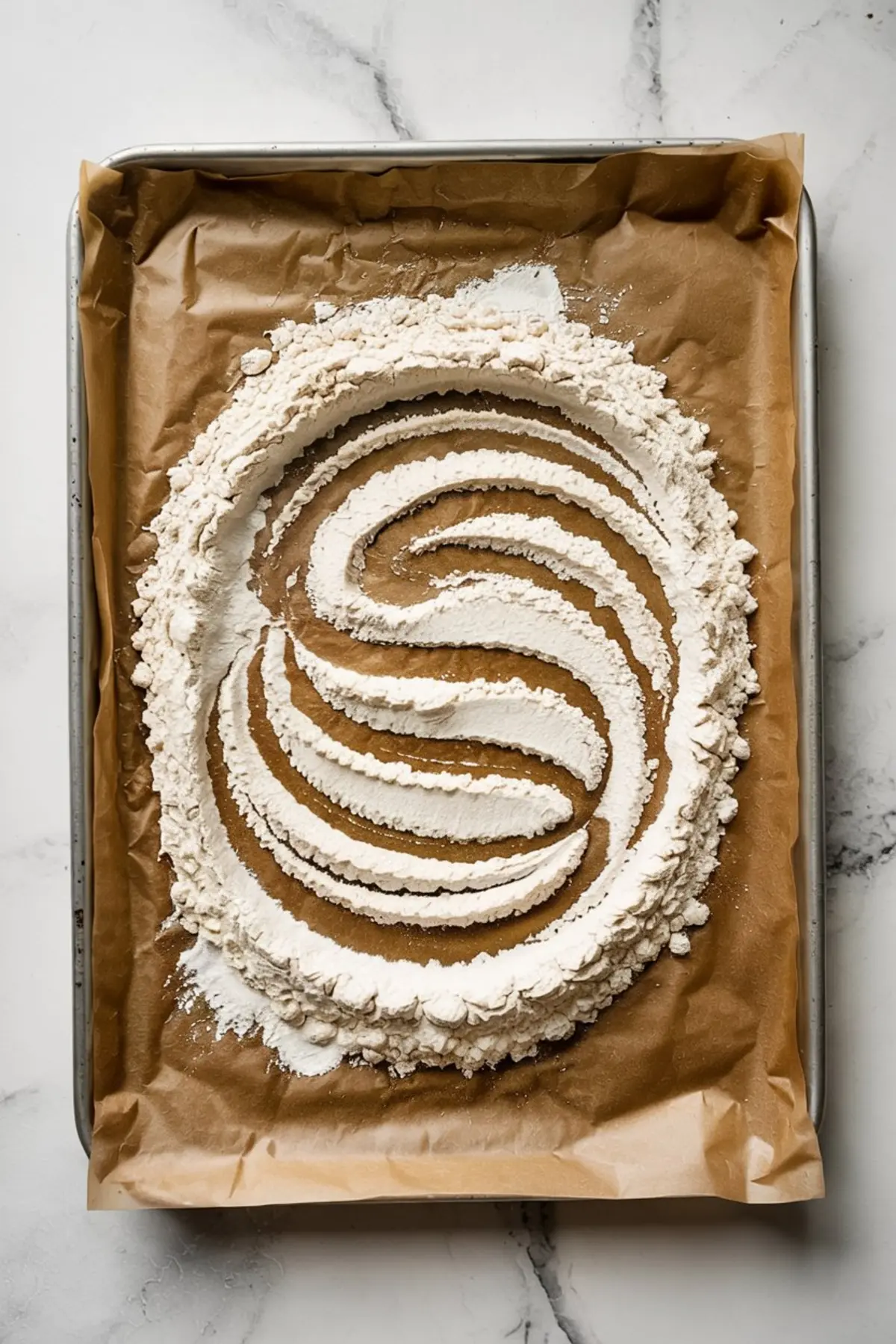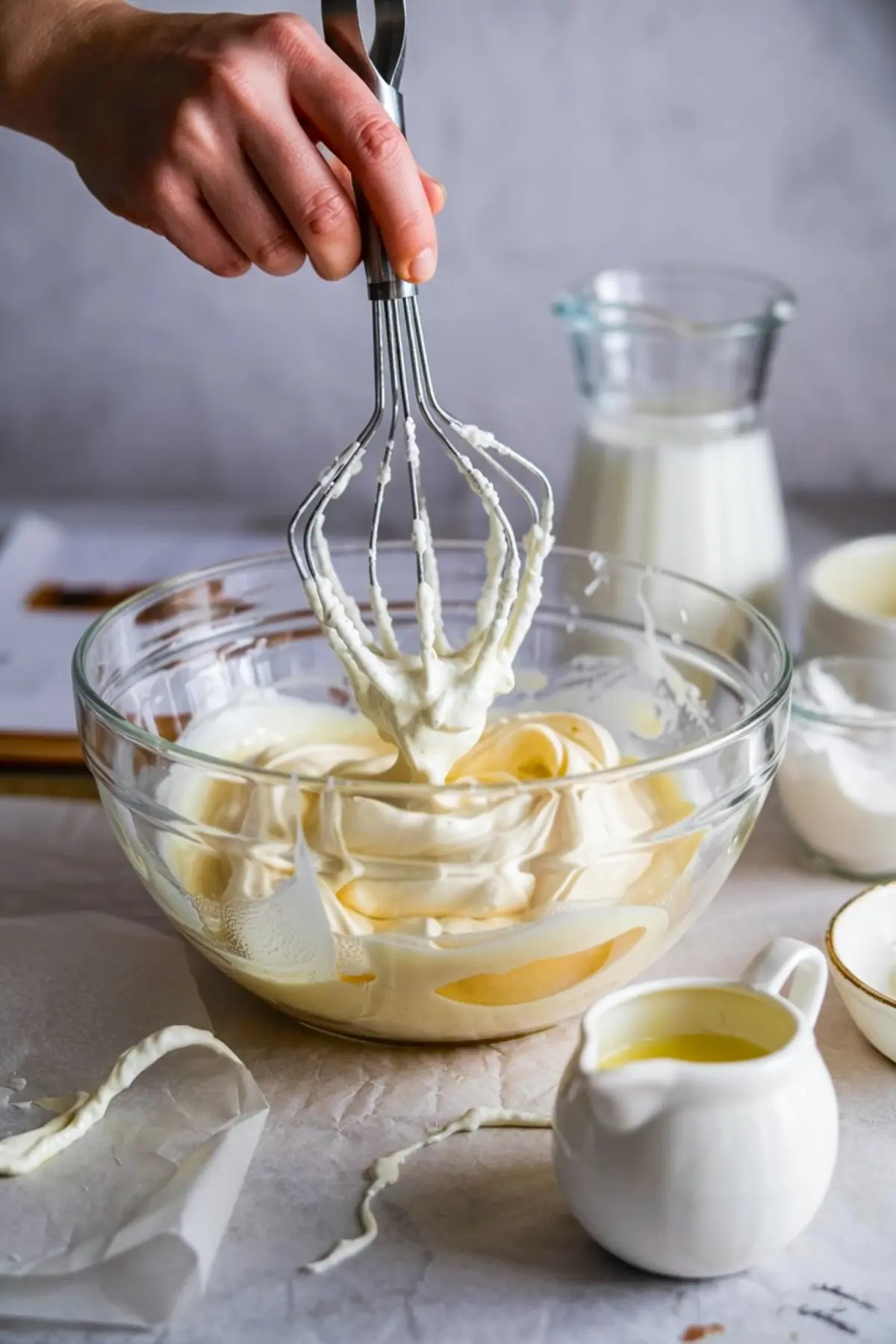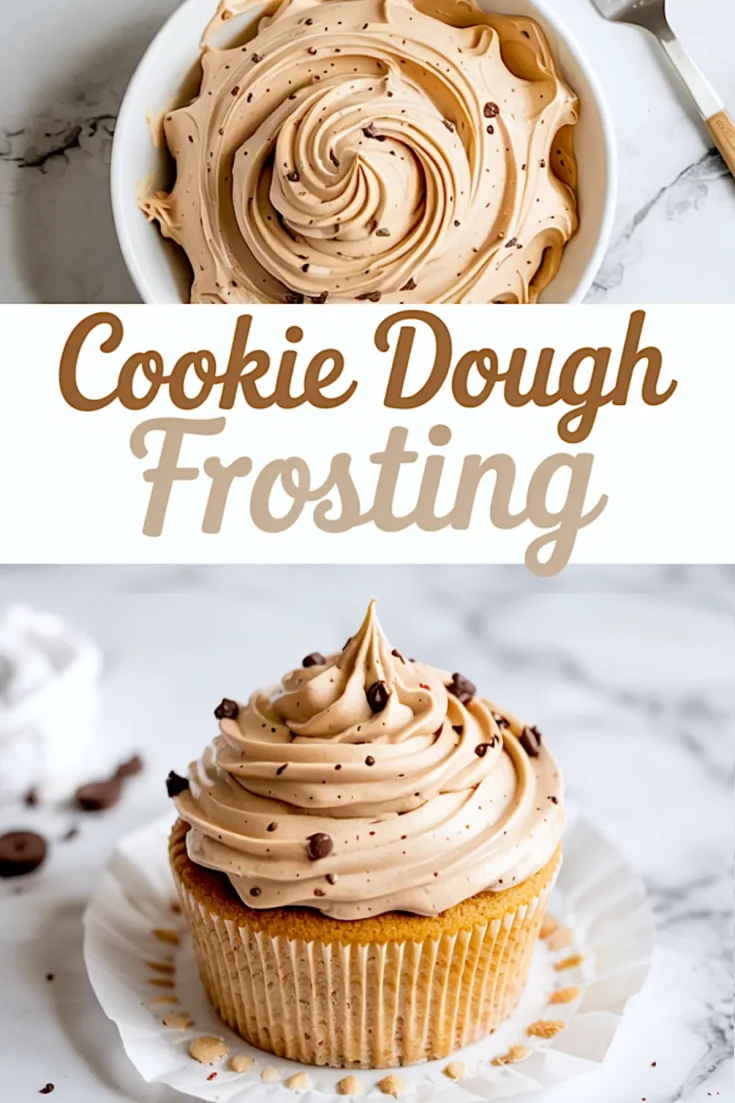This frosting tastes exactly like the cookie dough you used to sneak from the bowl.
Only this time, you don’t have to sneak. You just swirl it high on vanilla cupcakes or sandwich it between two soft cookies.
Cookie dough frosting blends the brown sugar chew of edible cookie dough with the fluff of a real buttercream recipe.
The result is creamy, sweet, and speckled with mini chocolate chips. It looks playful but feels polished good enough for bake sales and birthday cupcakes, familiar enough for a Tuesday night treat.
You’ll learn how to heat-treat flour safely, how to balance brown sugar with vanilla, and how to get that thick, spreadable texture that actually holds its shape. If you’re after a safe cookie dough to eat, this one is smooth, rich, and made for piping.
This frosting works beautifully on vanilla cupcakes with cookie dough frosting, cookie dough brownies, or spread thick across sheet cakes as a chocolate chip cookie dough icing.
It even holds up well as a cookie dough filling for layer cakes.

The Flavor Starts with Brown Sugar and Butter
Softened butter and packed light brown sugar are the base here.
Brown sugar brings that caramel warmth and soft golden color that makes this frosting taste unmistakably like edible cookies.
I’ve used both light and dark brown sugar in test batches. Light brown sugar gives a milder, more balanced sweetness.
Dark brown has more molasses and can overpower the vanilla. I keep a note in my binder: for anything frosting-based, light brown sugar gives a better structure and a cleaner flavor.

This first step is essential. Whip the butter and sugar longer than you think you need. I aim for at least three minutes.
It should look pale and airy like it could stand on its own as a butter spread.
For extra structure, especially if you’re planning to use it as a cookie dough filling between layers, give it a longer whip before adding any liquid.
If you want a basic version to try first, you can compare it to my vanilla buttercream frosting.
It’s where I usually send beginners before they branch out into flavored or textured frostings like this one.
How to Heat-Treat Flour the Right Way

Raw flour needs heat treatment, even in frosting.
This step takes just a few minutes but makes a huge difference in safety.
I spread the flour on a baking sheet and bake it at 350°F until it reaches 165°F internally.
I use an instant-read thermometer to check—it usually takes about 5–7 minutes. Once cool, the flour blends easily into the butter mixture without clumping.
This process is necessary for any frosting that includes raw flour, especially if you plan to serve it to kids or store it for more than a day.
If you’re experimenting with other types of flour, stick to all-purpose. Almond flour, even when toasted, changes the texture too much.
Cream, Vanilla, and the Right Consistency

Once the flour is mixed in, you’ll notice the frosting gets thick.
That’s normal. Cream helps loosen and fluff it without making it too soft to pipe.
I use heavy cream here for body and richness. Start with one tablespoon and only add more if it feels stiff or dry.
The vanilla matters. Real extract gives that classic cookie dough flavor, especially when paired with the salt and brown sugar. I avoid artificial vanilla in frostings like this—it tends to fade under the sugar.

This version is thick enough for piping but soft enough to spoon onto brownies or bars.
It doesn’t crust like sugar cookie frosting does, but it holds its shape longer than most soft frostings. If you prefer that sugary crust, you can look at this sugar cookie frosting recipe. It’s firmer but less creamy.
Mini Chocolate Chips Are Optional but Welcome
You can fold in mini chips at the end for texture. I usually do.
They give that familiar chocolate bite without weighing down the frosting.
Sometimes I skip them if I’m using the frosting for a layer cake filling.
They add crunch, which is great on top of cupcakes or brownies, but they can get in the way when slicing clean layers.
If you’re adding them, go with mini—not regular size.
They mix better and don’t sink.
For more inspiration with mix-ins, I sometimes refer back to my cinnamon roll frosting.
That one uses cream cheese, but the layering logic and spreadability are very similar.
Serving and Storing Like a Pro
This cookie dough frosting is best piped or spread fresh. It firms up in the fridge but needs to soften before reuse.
If you’re piping tall swirls on easy baking recipes desserts like cupcakes, frost them right before serving.
Chill leftovers in an airtight container for up to a week. When ready to use, let it sit at room temperature, then re-whip briefly to bring back the volume.
You can freeze this frosting too.
I usually portion it into a zip-top bag, flatten it, and freeze for up to a month. Let it thaw in the fridge overnight, then re-whip it the next day.
This one doesn’t crust, but it does firm up. For birthdays or events, you can frost the night before and store the finished dessert in a cool room.
If you want a fruity variation, you might enjoy my strawberry buttercream frosting.
It follows a similar method but with a berry-forward flavor that’s lovely for summer.
How It Compares to Ermine Frosting
This frosting is thicker and denser than my ermine frosting, which uses a cooked milk base.
I’ve used both for cupcake orders.
Ermine is silkier, more subtle, and less sweet. Cookie dough frosting, by contrast, is bold. You taste the brown sugar first, then the vanilla, then the soft chocolate crunch.
If you’re frosting something delicate, like chiffon cake, I’d go with ermine.
If you want to impress with flavor and texture, this cookie dough frosting holds its own.
Try It, Save It, Share It

You can use this frosting on almost anything: vanilla cupcakes, cookie bars, layer cakes, or spooned between graham crackers as a quick snack.
It’s the kind of recipe that adapts to your mood and disappears fast.
I like to swirl it tall on cupcakes and finish with a few chocolate chips on top.
It makes even a plain cake feel fun. And honestly, it tastes just as good straight from the bowl.
Save this recipe to your Pinterest board so you can come back to it next time you’re making cupcakes or brownies.
And if you try it, or if you tweak it leave a comment below. I’d love to hear what you paired it with, how you served it, or whether you added chips or left them out.
You never know who your tip might help next.
Cookie Dough Frosting Recipe

Cookie dough frosting is the kind of treat that makes cupcakes and brownies impossible to resist. It’s a smooth vanilla buttercream mixed with edible cookie dough, complete with mini chocolate chips for that nostalgic flavor. I like to swirl it on top of vanilla cupcakes with cookie dough frosting or use it as a filling for cookie dough brownies. Since it’s made without eggs, it’s completely safe to eat straight from the bowl—cookie dough to eat in its best form. It doubles as a chocolate chip cookie dough icing for cakes, turning simple desserts into something special. If you enjoy easy baking recipes desserts that taste indulgent but come together quickly, this frosting recipe should be on your list.
Ingredients
- 1 cup (226g) unsalted butter, softened
- ¾ cup (165g) packed light brown sugar (this gives both flavor and color)
- 1½ cups (180g) powdered sugar
- 1 cup (125g) all-purpose flour, heat-treated
- 2 tablespoons heavy cream (plus more if needed)
- 1½ teaspoons pure vanilla extract
- ½ teaspoon fine salt
- ½ cup mini chocolate chips (optional)
Instructions
Step 1: Heat-Treat the Flour
Spread flour on a baking sheet and bake at 350°F (175°C) for 5–7 minutes. Let cool before using.
Step 2: Cream Butter and Brown Sugar
In a large mixing bowl, beat butter and brown sugar together for 2–3 minutes until fluffy. This is where the golden color and deep flavor develop.
Step 3: Add Vanilla and Salt
Mix in vanilla and salt until smooth.
Step 4: Add Powdered Sugar and Flour
Gradually beat in powdered sugar and the cooled, heat-treated flour. It may look thick at first.
Step 5: Add Cream and Whip
Pour in heavy cream, one tablespoon at a time, until the frosting is light, fluffy, and pipeable.
Step 6: (Optional) Fold in Mini Chocolate Chips
Stir in chocolate chips for extra crunch and that cookie dough vibe. The frosting itself is fully flavored even without them.
Step 7: Swirl and Serve
Use immediately to frost cakes, cupcakes, or brownies. For a bakery-style look, pipe tall swirls and sprinkle extra mini chips on top.
Notes
To heat-treat flour safely, use an instant-read thermometer to confirm it reaches 165°F. Store leftover frosting in an airtight container in the refrigerator for up to 1 week. Let it come to room temperature and re-whip before using.
Nutrition Information
Yield
1Serving Size
1Amount Per Serving Calories 1128Total Fat 50gSaturated Fat 30gTrans Fat 1gUnsaturated Fat 17gCholesterol 64mgSodium 1170mgCarbohydrates 161gFiber 9gSugar 58gProtein 18g

